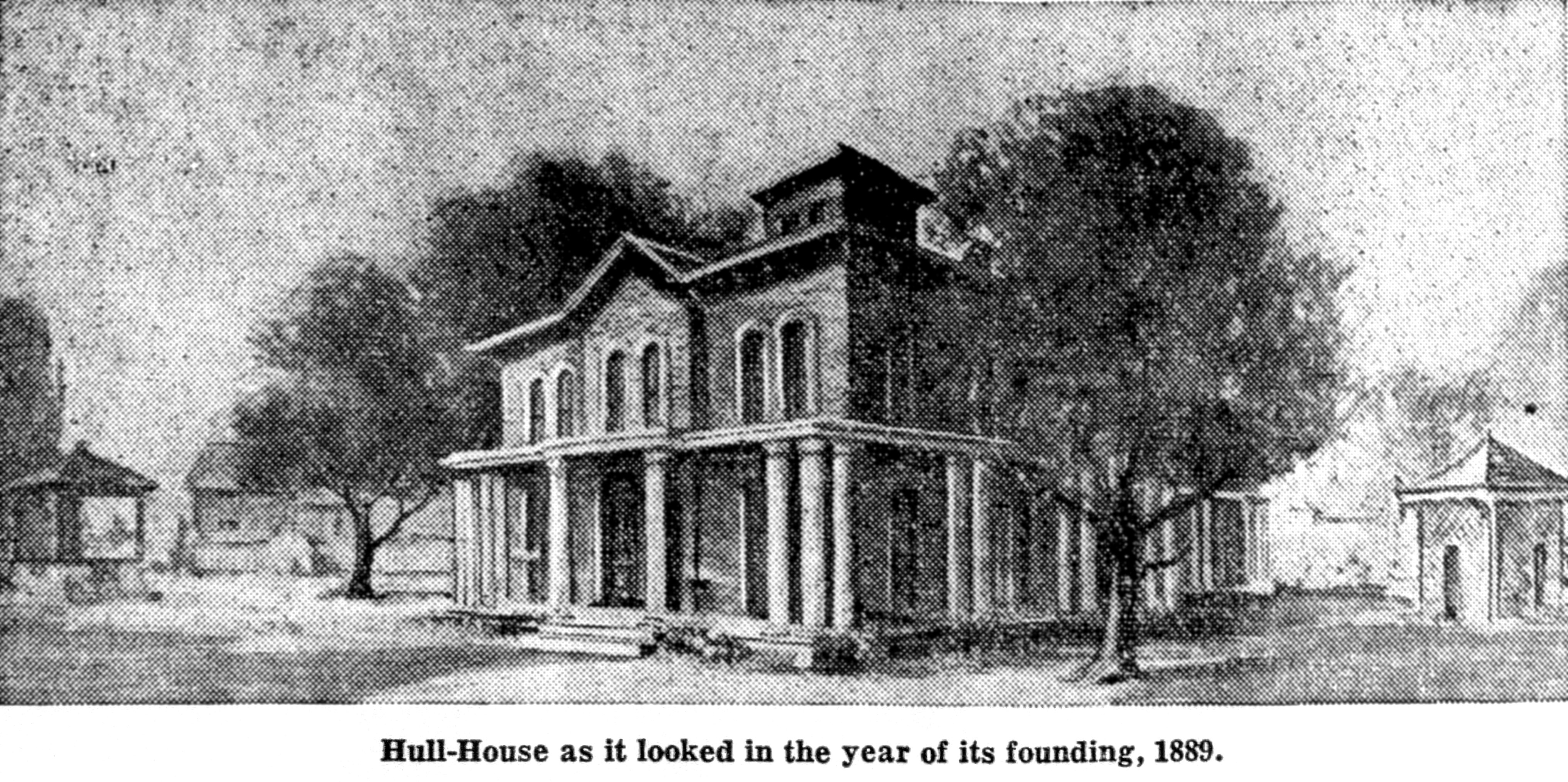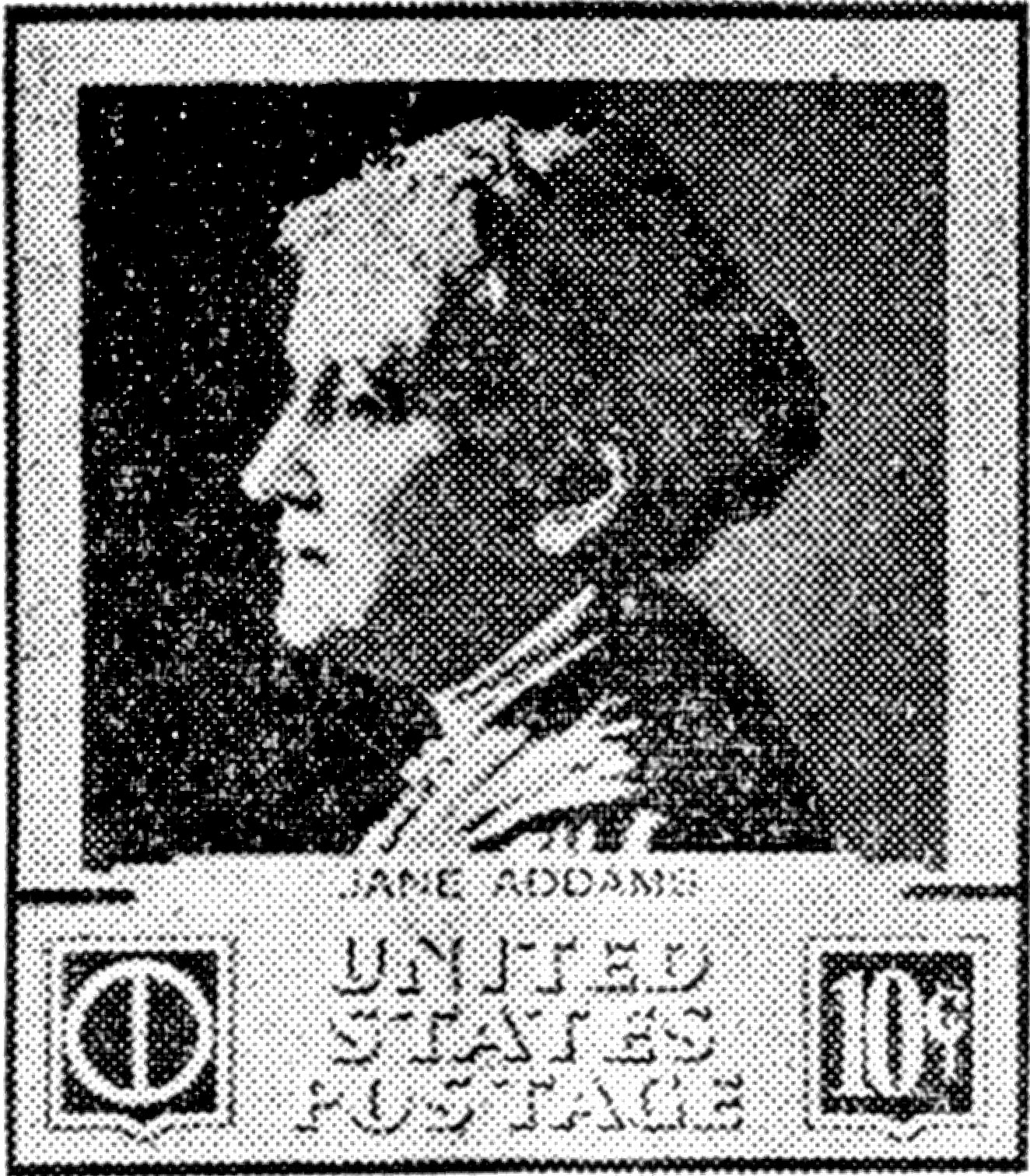Honor Memory of a Country Girl Who Founded America's First Settlement House in the Slums of a Great City

Hull-House as it looked in the year of its founding, 1889.
By Elmo Scott Watson
(Released by Western Newspaper Union)
ONCE upon a time a little girl from the country watched some children playing in the dirty, narrow streets that criss-crossed the “shanty town” of one of Illinois' thriving industrial centers, whereupon she said to her father beside her in the carriage, “When I grow up I'm going to have a big house with a big yard and I'm going to ask all those children to come over and play.”
“That's a fine plan, Jenny,” her father agreed. “I hope you will carry it out some day.” And she did, for that little girl was six-year-old Jane Addams who, 23 years later, founded Chicago's Hull House, America's first and for 50 years world-famous settlement.
Although Hull-House is, after the stockyards, a Chicago visitor's first stopping place, Jane Addams is remembered for more than Hull-House. Her efforts in behalf of laboring men and women throughout the state and the nation, and for world peace combine with her Hull-House work to earn her top ranking in the field of social science and, as a scientist, she is to be honored with a commemorative postage stamp, The Jane Addams stamp, one of the “Famous Americans” series, is having its first day of sale on April 26 at the Hull-House post office, Chicago's first subpostal station and where Miss Addams served as postmistress for 38 years.
Golden Jubilee Celebration.
This first day sale of the Jane Addams stamp opens a month long celebration of the settlement's golden jubilee. In that celebration, Hull-House neighbors from along Chicago&apo;s crowded Halsted street will join with the city's civic leaders and with many of the nation's best-known men and women. At its climax, on May 23, members of the 18 nationality groups the settlement now will hold a neighborhood fiesta, to be followed by a national broadcast, with Mayor Fiorello LaGuardia of New York city, Gerard Swope, former president of the General Electric company and new chairman of the New York Housing authority, and President Robert Maynard Hutchins of the University of Chicago, as speakers.
Thus, America will pay tribute to the country-bred girl who devoted her life and the small fortune left her by her prosperous miller-father to the alleviation of hardship and suffering and to teaching the principles of democracy among the immigrant poor of the nation's second largest city.
Jane Addams was born on September 6, 1860, in the little village of Cedarville, six miles northwest of Freeport, Ill. In September, 1877, just after her seventeenth birthday she entered Rockford seminary.
In her freshman Latin class, Jane Addams met Ellen Gates Starr. Emotional Ellen, always close to laughter or to tears, and calm Jane were to be life-long friends. It was to Ellen that Jane first told her plans to find a house among Chicago's poor and settle down to be a good neighbor there, and it was Ellen who cried, “Why, Jeannie, how splendid! I'll live with you. We'll do it together.”
But that was many years later. During her college days, Jane, a brilliant and popular student, was planning to study medicine and to become a doctor and work among the poor. After her graduation she enrolled at the Woman's Medical college in Philadelphia. Just as she was finishing her summer vacation and planning her trip East, her father died. It was a cruel blow to Jane, but she determined to carry out her plan, so the family moved to Philadelphia. The nervous shock of her father's death brought on an old illness and she spent the spring in a hospital. Doctors recommended an ocean voyage, so Jane and Mrs. Addams sailed for Europe, where they stayed for two years.
But Jane did not visit only art galleries and ruins on her tour of Europe. In London, she went into the East End slums and watched the hungry and homeless battle for rotting vegetables and fish in the Saturday night auction which disposed of food too spoiled to be saved for the Monday market.
Growing deep within her was a burning desire to be of service to humanity, although she knew by now that she could not endure the rigors of a medical course. Having returned to the United States, Jane set out again two years later for another visit to Europe. This time, she met her friend Ellen Gates Starr and they toured together.
On her way home, Jane Addams visited Toynbee Hall, established in London as a memorial to Arnold Toynbee, the Oxford tutor who had died at 31, worn out by his work for social reforms. Here came the little milliner, furniture polishers and clerks, and silk weavers of East London. Young university men lived at the hall and taught them French or carpentry, music or shorthand, boxing or literature. There were as library, an athletic field and a hall for parties.

The Old Hull Mansion.
Jane Addams wanted the same thing for herself in the midst of the poor in an American city, and, in the spring of 1889, she went to Chicago to look for a place for her “house.” On Chicago's West Side, in a colorful patchwork of races —Italians, Russian and Polish Jews, Bohemians and Irish, Scandinavians and Rumanians, Germans, Swiss, French and French Canadians— she found the old Hull mansion, at Polk and Halsted streets.
A furniture factory was using the first floor for storage and the second floor was let to lodgers who thought the attic was haunted. Jane and Ellen rented the whole second floor and a part of the first, and set a corps of carpenters, plasterers and paper-hangers to work to make it livable. Jane spent all the savings from her income of the legacy left her by her father and Ellen donated the remains of her teacher’s salary.
The night of September 14, 1889, was the first they spent in the house. There were three of them, Jane and Ellen and motherly Mary Keyser, who came to do the housekeeping and ended by caring for half the neighbor children. Going to market, Miss Keyser invited the wives of the butcher, the baker and the saloonkeeper to tea, and they came first out of curiosity and again out of liking. Then the girls from the furniture factory were supper guests and decided they would like to have a class in literature. So people began to trickle in and tell around that the young ladies treated them well. They didn't seem to want anything out of you but just to be sociable and to give you a good time, and perhaps to teach you something.
Tired mothers heard about the house and left their babies when they went to work, black-eyed girls with gold hoops in their ears shyly asked to play the piano for dancing. Soon Jane Addams and Ellen Starr were deep in the stream of neighborhood life, dressing new babies and closing the eyes of the dead.
Higher Civic and Social Life.
When this neighborhood venture was incorporated, some time later, the charter gave the objects of incorporation as follows:
“To provide a center for a higher civic and social life; to institute and maintain educational and philanthropic enterprises and to investigate and improve the conditions of the industrial districts of Chicago.”
Those “objects” are put, whether by accident or design, in the chronological order in which they had appeared. It was to provide a center for social life that the young women rented the old mansion. When within two weeks a dozen young women of the neighborhood were invited to a “reading party” in the evening and when soon afterward a kindergarten was started in the drawing room, the first “educational and philanthropic enterprises” were-instituted. And before the end of the year, the residents had begun to “investigate and improve the conditions” in their own neighborhood.
So, Hull-House grew and Jane Addams' interest and influence grew with it in ever-widening circles. As she sought to help the neighbors with their problems, she campaigned for improved and more sanitary living conditions for the community, and became involved in labor legislation and organization. Long before the World war, Jane Addams firmly believed in arbitration as the settlement of difficulties between nations and organized the women of the world in an effort to accomplish it.
For her efforts for world peace, she shared the Nobel peace prize of 1931 with Dr. Nicholas Murray Butler. She was the first woman to be awarded an honorary degree by many universities, among them the conservative Yale. In numerous polls, she was named America's leading woman citizen, the nation's “uncrowned queen” and other complimentary titles.
In Europe, Jane Addams was even more famous than in her home country, and, in 1935, the year of her death, the Turkish government honored her with a special postage stamp.
Jane Addams died on May 21, 1935. Plans for the anniversary celebration are directed by Miss Charlotte Carr, now the settlement's resident director, who points out “It behooves us, in planning for Hull-House's second half-century, to live up to Miss Addams' reputation, not on it.”
Physically, the Hull-House of today is a far cry from what it was that autumn day in 1889 when Jane Addams, Ellen Gates Starr and Mary Keyser took up their residence. Before the end of that first year, other like-minded women had joined them there. From all over the city, and soon from all over the world, men and women interested in social service came to offer their help to Jane Addams. As in Toynbee Hall, these people opened classes to teach the lesser privileged.
Hull-House now occupies two full city blocks, has 13 buildings and, in addition, maintains a 72 acre summer camp, out in the country north of Chicago. During last year, more than 350,000 persons attended Hull-House classes and participated in Hull House activities. In 1939, more than 30,000 visitors came to Hull House from all parts of the world.
Indeed, in the past 50 years, almost 2,000,000 boys and girls and their fathers and mothers have accepted Miss Addams' invitation to “come over and play.”
Honor Memory of a Country Girl Who Founded America's First Settlement House in the Slums of a Great City, The Carbon County News, Red Lodge, Montana, Friday May 3, 1940, Page 2. (PDF)